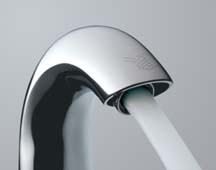
“For specifying engineers and building owners, water conservation has become increasingly important over the past few years with new regulations being put into place,” says commercial faucets product manager at Chicago Faucets Michael Rosen.
As much as 49 percent of the United States is experiencing drought conditions, according to the National Climatic Data Center. This pressure on facility managers to save water leads them to the easy decision to install sensor-operated fixtures, which provide the benefit of more control over water consumption than manual models.
Several products currently on the market offer water and energy savings, but also tackle labor- and time-saving issues for builders.
“Beyond price, builders are looking for electronic plumbing products that are easy to install,” says Rosen, whose company markets its Galileo electronic faucet with Synapse Commander software that provides set-up and diagnostic capabilities from a Palm OS-enabled handheld device. “For example, battery-powered electronic faucets with above-deck electronics are preferred because they install exactly like mechanical faucets. The fewer number of procedures outside the average mechanical installation the better.”
Sloan’s Optima® sensor-operated fixtures come preassembled for a quick installation and eliminate field adjustments. Its anti-reflective circuitry also eliminates sensor detection errors from stainless-steel stall doors, mirrors and other surfaces, which can activate fixtures and waste water while users aren’t present.
Water Works
While most electronic faucets are battery-powered (which need replacement) or hardwired (which increases installment costs), TOTO USA has recently introduced a self-sufficient sensor faucet.
The EcoPower generates its own electricity every time water spins its small internal turbine (see schematic). The energy is then stored in its rechargeable battery, and can be powered with as few as five uses per day.
Keeping Clean
A recent outbreak of salmonella at a Chicago-area Chili’s Grill & Bar restaurant shut the facility down for 10 days. And it all could have been avoided by simple hand washing.“For public restroom users, the increased hygiene associated with the ‘no-touch’ aspect of electronic plumbing is extremely important,” Rosen says. Added cleanliness in washrooms is another major motivator that has spurred building managers to request more sanitary plumbing fixtures — from faucets and water closets to soap dispensers and hand dryers.
The Center for Disease Control reports that after using a public restroom, a single hand can host as many as 200 million bacteria. Re-touching dirty fixtures after hands have been washed only re-contaminates users of the facility.
The Food and Drug Administration’s protocol requires four seconds to wet hands, 20 seconds to soap up, and four more seconds for rinsing. Increasing technology allows for some sensor-operated faucets to prompt food service workers with an LED screen to indicate proper hand-washing time.
So whether the driving force for installing sensor-operated plumbing fixtures is water conservation, ease of maintenance or cleanliness, electronics in today’s bathrooms seems to be the answer. Only time can tell how far technology can take us in the bathrooms of tomorrow.